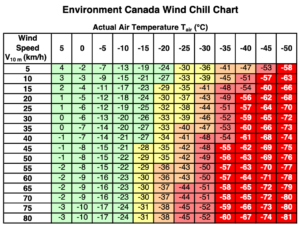How to Avoid Getting Frostbite!
Frostbite is a scary word. There. We’ve said it “frostbite.” Since you don’t see many Canadians with black noses and fingers, it’s obviously pretty easy to prevent frostbite.
Frostbite is most common on the fingers, toes, nose, ears, cheeks and chin. Here are tips to help you stay safe and warm.
- Limit time outdoors in cold, wet or windy weather. Pay attention to weather forecasts and wind chill readings. In very cold, windy weather, exposed skin can develop frostbite in a matter of minutes. See the Windchill Chart below.
- Dress in several layers of loose, warm clothing. Air trapped between the layers of clothing acts as insulation against the cold. Wear windproof and waterproof outer garments to protect against wind, snow and rain. Choose underpants that wick moisture away from your skin. Change out of wet clothing — particularly gloves, hats and socks — as soon as possible.
- Wear a hat that fully covers your ears. Heavy woollen, fleece lined or windproof materials make the best headwear for cold protection. And make sure you call your hat a “toque” (pronounced two-ck). You’re in Canada now. Trying to speak Canadian will endear you to the locals, even if you pronounce it “tok-cue”.
- Wear mittens rather than gloves. Let your fingers hang out together, and keep each other warm. Mittens provide better protection than gloves. Or try a thin pair of glove liners made of a wicking material (like polypropylene) under a pair of heavier gloves or mittens.
- Wear socks that fit well, wick moisture and provide insulation. You might also try hand and foot warmers. Be sure the foot warmers don’t make your boots too tight, restricting blood flow. Always choose woollen socks or moisture wicking socks. You will find that your feet will sweat in cars and in shops. Woollen socks and moisture wicking socks stop your feet from getting cold after they have sweated. Cotton socks are a bad idea, your feet will sweat and will get cold as soon as you step outside.
- Watch for signs of frostbite. Early signs of frostbite include red or pale skin, prickling, and numbness.
- Plan to protect yourself. When travelling in cold weather, carry emergency supplies and warm clothing in case you become stranded. If you’ll be in remote territory, tell others your route and expected return date.
- Don’t drink alcohol if you plan to be outdoors in cold weather. Alcoholic beverages cause your body to lose heat faster. Also, people make dumb decisions when drunk. Like “let’s get naked and jump in the Bow River”. Don’t do that. It’s a bad idea.
- Eat well-balanced meals and stay hydrated. Doing this even before you go out in the cold will help you stay warm. And if you do become cold, drinking warm, sweet beverages, such as hot chocolate, will help you warm up. Mmmmm … hot chocolate!
- Keep moving. Exercise can get the blood flowing and help you stay warm, but don’t do it to the point of exhaustion. No one is trying to win a triathlon in freezing conditions.
All of this sounds pretty scary but people have successfully lived and enjoyed the outdoors in cold climates for a long time. If you prepare, dress appropriately and know your limits then you will have a wonderful and memorable vacation.




